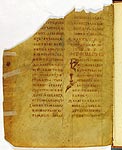Kupryianov or Novgorod Leaves. Gospel Aprakos
10-11th centt. (?). Middle Bulgarian version(?). Fragment
F (340 ı 260/280). 2 leaves.
Parchment. Ink, cinnabar, colours, gold.
It is written in a uncial hand in two columns. Text has ekphonetic note signs.
Initials of the Old Byzantine style in colours with application of gold (fols. 1, 2v) were executed in the same technique as initials in the Ostromir Gospel: in colours and gold on a dark cherry-coloured background. Headings of the readings were written in gold that has peeled away to a great extent at present.
The Kupryianov Leaves was discovered by I. K. Kupryianov at the library of St Sophia's Cathedral in Novgorod. There are diverse opinions about their origin and connection with the Ostromir Gospel. From the point of view of Philipp Fortunatov, these two ancient manuscripts derived from a common original, but the language of the Ostromir Gospel is older than the language of the Kupryianov Leaves. The assumption of Vladimir Moshin is that the Kupryianov Leaves were a part of the codex from which the Ostromir Gospel was copied. In Moshin's opinion, it is possible that this Gospel, now lacking, may have belonged to Tsar of Bulgaria Samuil, who sent it and other service books to the Grand Prince Vladimir in connection with the adoption of Christianity in Russia. Then the Gospel along with other books was transferred to Novgorod, where in the middle of the 11th century, in the scientist's judgement, this royal codex may have served as a model for the Gospel, commissioned by Ostromir, the governor of Novgorod. The place of origin of the missing codex, that contained the Kupryianov Leaves, is to be Ohrid, in Moshin's estimation.
In 1865 the manuscript was acquired the Imperial Public Library from I. K. Kupryianov.
Shelfmark: –Õ¡. F.n.1.58.





